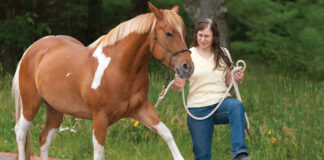
Straw
Pro: Offers cushioning
Cons: Can be dusty or moldy; can be palatable, especially oat straw; not absorbent of moisture or odors
Pelleted straw
Pros: Absorbent; low dust
Con: More expensive form of stall bedding
Wood shavings or sawdust
Pros: Less dusty than straw; very absorbent; may be available from a local sawmill for low or no cost; not palatable
Cons: Must ensure no black walnut shavings are included; needs to be picked from hooves regularly
Wood chips
Pros: Very absorbent and comfortable; low dust
Cons: More difficult to keep clean; must ensure no black walnut chips are included in the stall’s bedding
Pelleted wood
Pros: Very absorbent; low dust; transported in small volume and then expands when wet; can contain odor-absorbing additives
Cons: Not appropriate for use on a dirt floor because it will absorb moisture from floor; may be expensive
Sand
Pros: Doesn’t harbor bacteria; very comfortable; not palatable
Cons: Not absorbent; difficult to dispose of; can cause sand colic if eaten off of
Ground corn stalks and cobs
Pro: Offers cushioning when used in volume
Cons: Not often readily available; may be palatable as stall bedding
This article originally appeared in the September 2017 issue of Horse Illustrated magazine. Click here to subscribe!





